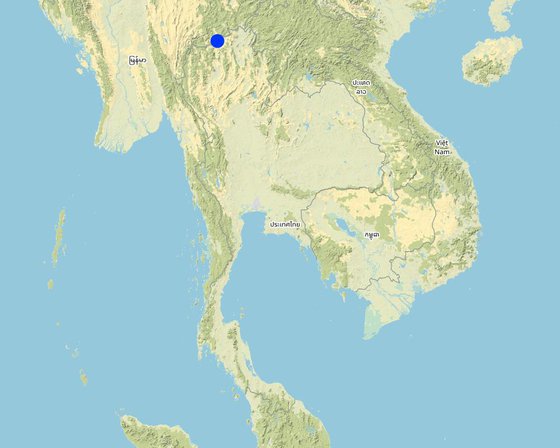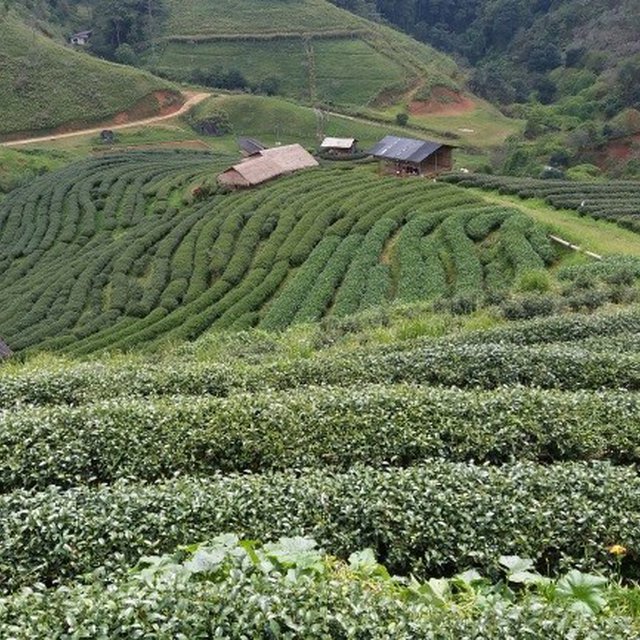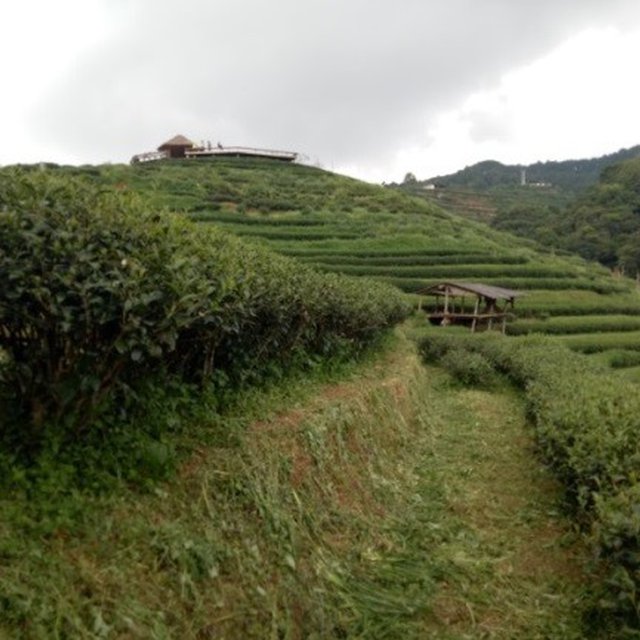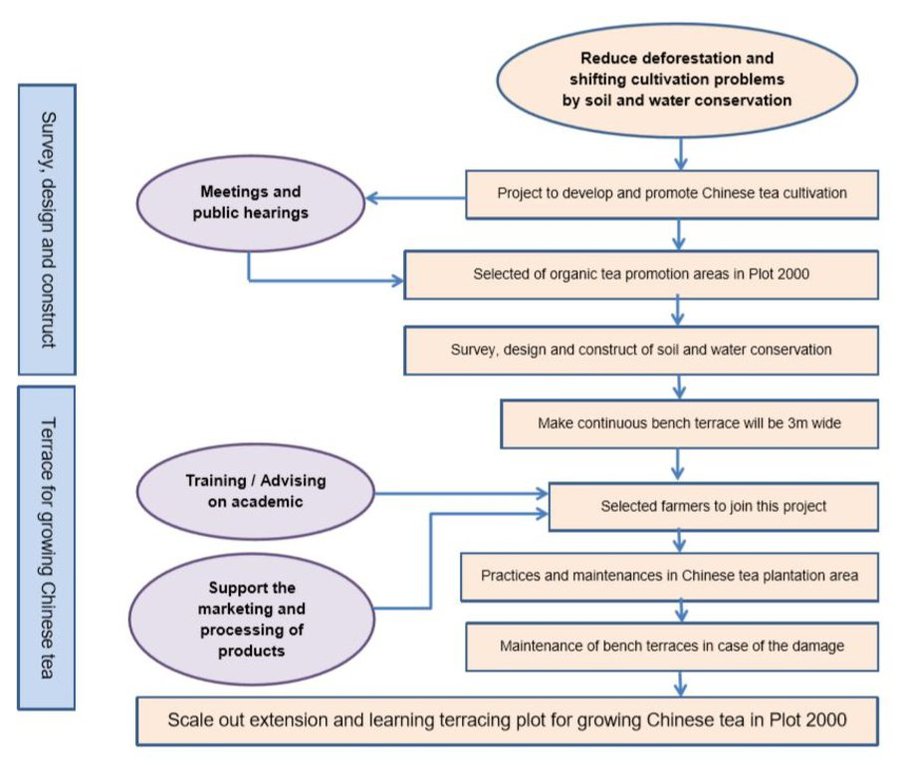Promotion of Organic Tea Production under Bench Terraces
(Tailandia)
Continuous bench terrace
Descripción
Promotion of continuous bench terraces for sustainable tea plantations in steep areas of the northern region highlands.
The approach is to develop and promote sustainable agriculture on steep slopes by establishing continuous bench terraces. Under this system, hilltribe farmers can produce good quality Chinese tea, and send their product to a processing factory nearby, which will create stable and high incomes and raise the quality of life. This production/ conservation system aims also to reduce deforestation and shifting cultivation problems, which lead to the degradation of soil and land. As such, soil and water conservation in this upstream sloping highland should promote and encourage appropriate sustainable land management to preserve natural resources and the environment.
In the early stage, Angkhang Royal Agricultural Station initiated this project to develop and promote Chinese tea cultivation on steep land, with close cooperation from the Land Development Department (LDD) to design the continuous bench terraces instead of the cold-climate fruit trees, which had greatly deteriorated. Local officers had allocated land (without ownership) to Palaung hilltribe people who were selected and guaranteed by the community leader for their aptitude and ability to cultivate Chinese tea according to the Good Agricultural Practices (GAP) Guidelines, and set up a Chinese tea producers group at Plot 2000. Angkhang Royal Agricultural Station organized this programme and trained them and also arranged for some local officers to advise on soil management, fertilizer use, and disease and pest control. Vetiver grass planting was introduced to maintain the terrace and road edges; compost was produced to use for improving soil properties and reducing their production cost, and cultivation materials were supplied to all land users through disbursement under the management of Doi Angkhang Agricultural Cooperatives. Local officers also supported marketing through purchasing at the guaranteed price according to the quality of the tea, and set up tea processing factories in this area. The project encourages all land users to observe and maintain their tea bushes and the land around them. Currently all land users are aware of how to sustainably use and maintain their land and soil resources. Moreover, local officers advise how to repair bench terraces themselves; however, if the damage is serious, the LDD officers will come in to help them repair.
Lugar

Lugar: Extension area for Chinese tea plantation (Farm 2000) at Angkhang Royal Agricultural Station, Mae Ngon Sub-district, Fang District,Chiang Mai Province, Chiang Mai Province, Tailandia
Georreferencia de sitios seleccionados
Dato de inicio: 1999
Año de conclusión: n.d.
Tipo de Enfoque
-
tradicional/ local
-
iniciativa local reciente/ innovadora
-
proyecto/ basado en un programa

Overview of the tea plantation in "Farm 2000" (Ms. Tanomkwan Tipvong)

(Ms. Tanomkwan Tipvong)
Metas del Enfoque y entorno facilitador
Propósitos/ objetivos principales del Enfoque
The first objective is to enable hilltribe farmers, through suitable soil and water conservation measures, to produce good quality Chinese tea on the highland. The second objective is to create a stable income and raise the quality of life, where it is very important to ensure sustainable landuse without damaging natural resources and the environment. The third is to reduce forest encroachment problems in the highland and watershed areas of the northern region of Thailand.
Condiciones que facilitan la implementación de la/s Tecnología/s aplicadas bajo el Enfoque
-
Disponibilidad/ acceso a recursos y servicios financieros : Angkhang Agricultural Cooperatives supported production factors to land users and cooperatives officers will monitor and evaluate this process.
-
Entorno institucional: Land user network as cooperative of tea plantation group with cooperation in compost or organic fertilizers production
-
Marco de trabajo legal (tenencia de tierra, derechos de uso de tierra y agua): Almost land users did not have right in land ownership, but they have right to use the allocated land, which these land are allocated by the Royal Project.
-
Políticas: Government policy and Royal project supported the budget and implementation activities
-
Gobernanza de tierras (toma de decisiones, implementación y aplicación): Royal project and government agencies regulated land use planning and take care on soil and land management in this area.
-
Conocimiento de MST, acceso a apoyo técnico: The officers of Angkhang Royal Agricultural Station advise land users to manage soil and land, including tea production and process.
-
Mercados (para comprar insumos, vender productos) y precios: They have tea processing factories in this area.
-
Otros: None
Condiciones que impiden la implementación de la/s Tecnología/s aplicadas bajo el Enfoque
Participación y roles de las partes interesadas involucradas
Partes interesadas involucradas en el Enfoque y sus roles
| ¿Qué partes interesadas/ entidades implementadoras estuvieron involucradas en el Enfoque? |
Especifique las partes interesadas |
Describa los roles de las partes interesadas |
| usuarios locales de tierras/ comunidades locales |
All farmers belong to the hilltribe Palaung ethnic group. |
All land users take care of bench terraces with advice from station officers. |
| organizaciones comunitarias |
Angkhang Royal Agricultural Station, The Royal Project |
The station officers extend and promote the occupation, encourage and advise in technology transfer the technical matter and knowledge to farmers. |
| profesores/ niños en edad escolar/ estudiantes |
School children and students |
Training course and study tour in the area |
| gobierno local |
Several local government agencies are directly involved in this process, including officers from the station and the Royal Project. |
The station officers extend and promote the occupation, encourage and advise the farmers in technical knowledge, support production facilities and processing factory. |
| gobierno nacional (planificadores, autoridades) |
Administrative officers in department and ministry level |
Making decisions and creating policy |
Involucramiento de los usuarios locales de tierras/ comunidades locales en las distintas fases del Enfoque
ninguno
pasivo
apoyo externo
interactivo
auto-movilización
iniciación/ motivación
Angkhang Royal Agricultural Station created continuous bench terraces as a soil and water conservation measure in the former degraded cold-climate fruit tree plot. They informed all land users about land allocation and zoning for suitable economic crops and trees, including Chinese tea in Plot 2000.
planificación
Almost all land users (Palaung hilltribe) have been allocated land for planting Chinese tea with good agricultural practices (GAP) system in Plot 2000.
implementación
The LDD has been responsible for conducting soil and land survey, designing and constructing soil and water conservation measures, with close collaboration with Angkhang Royal Agricultural Station.
monitoreo y evaluación
All Palaung hilltribe land users in this area have to maintain/repair the bench terraces in their allocated land.
Flujograma
Flow chart Operating procedures of bench terrace:
1. The organic Chinese tea plantation project is emphasized to promote and develop career of hilltribe people around the area of Angkhang Royal Agricultural Station to reduce forest encroachment and shifting cultivation and encourage them to use the land in a sustainable way with stable and high income.
2. Angkhang Royal Agricultural Station has selected the area of old cold-climate crops where soil has deteriorated; the station officers need to reshape the land and construct suitable conservation measures in this sloping area.
3. In 1999, Land Development Department (LDD) supported in the survey, design and construction of soil and water conservation measures as continuous bench terraces. The distance between two terraces and the vertical interval (VI) depend on the slope of the area, but the cultivation area of each terrace will be 3m wide.
4. The Angkhang Royal Agricultural Station has selected farmers to join this project by considering their aptitude, ability and opportunity for further development in organic Chinese tea plantation. Almost all land users have been approved by community leaders to practice and implement following the instruction from extension officers.
5. All selected land users should practice and maintenance as recommended by station officers. In planting tea, farmers will dig a small furrow along the terrace around 30cm deep and 30cm wide. Tea seedlings will be planted in the furrow with a spacing of 40-50 cm between trees (around 2,000 plants/rai). Surface soil around these tea seedlings will be mulched to maintain suitable soil moisture.
6. Farmers will produce organic Chinese tea so they need to avoid applying chemical fertilizers and other chemical substances, but limit the use only to natural materials. Compost is applied at a rate of 2 kg/tree along both sides of the tea canopy, and incorporated about 15 cm below the soil surface. This compost rate may be applied 3 times a year.
7. The Chinese tea is usually harvested from April to December, and will receive nourishment/maintenance ( January-March). At present, the No. 12 variety has an average yield of 800 kg/rai, with some 5-6 harvests a year, while the soft stem variety has an average yield of 600 kg/rai, with some 4-5 harvests a year. The station has received a budget from the Taiwanese government and the Institute of Highland Area Development to support the processing factory building, machinery and necessary techniques.
8. Maintenance of damaged bench terraces: all land users will repair by themselves in the dry season. In the serious case of erosion, the LDD will support such maintenance. In addition, vetiver grass is planted to strengthen the edge of the terraces.

Autor: Ms.Tanomkwan Tipvong
La toma de decisiones en la selección de Tecnología MST
Las decisiones fueron tomadas por
-
solamente usuarios de tierras (autoiniciativa)
-
principalmente usuarios de tierras con el apoyo de especialistas MST
-
todos los actores relevantes, como parte de un enfoque participativo
-
principalmente por especialistas MST en consulta con usuarios de tierras
-
solo por especialistas MST
-
por políticos/ líderes
La toma de decisiones se basa en
-
la evaluación de conocimiento MST bien documentado (la toma de decisiones se basa en evidencia)
-
hallazgos de investigaciones
-
la experiencia personal y opiniones (no documentadas)
-
Policies and legal measures
Apoyo técnico, fortalecimiento institucional y gestión del conocimiento
Las siguientes actividades o servicios fueron parte del enfoque
-
Construcción de capacidades / capacitación
-
Servicio de asesoría
-
Fortalecimiento institucional (desarrollo institucional)
-
Monitoreo y evaluación
-
Investigación
Construcción de capacidades/ capacitación
Se proporcionó capacitación a las siguientes partes interesadas
-
usuarios de tierras
-
personal de campo/ consejeros
Forma de capacitación
-
en el contexto de trabajo
-
de agricultor a agricultor
-
áreas de demostración
-
reuniones públicas
-
cursos
-
Mmonthly meeting
Temas avanzados
Implementation activities, how to solve some problems, maintain and repair conservation measure, vetiver grass plantation and others
Servicio de asesoría
Se proporcionó servicio de asesoría
-
en los campos de los usuarios de tierras
-
en centros permanentes
-
Fortalecimiento institucional
Se fortalecieron/ establecieron instituciones
-
no
-
sí, un poco
-
sí, moderadamente
-
sí, mucho
Describa la institución, los roles y las responsabilidades, miembros, etc.
All land users (from the Palaung hilltribe) have been selected as members to promote and implement organic Chinese tea plantation with their awareness to maintain and take care of conservation measures for sustainable use of this land.
Tipo de apoyo
-
financiero
-
construcción de capacidades/ entrenamiento
-
equipo
-
budget in repair structure
Detalles adicionales
The Angkhang station gives a support budget to repair the bench terrace about 500 baht per rai.
Monitoreo y evaluación
Angkhang Royal Agricultural Station set up a monitoring and evaluation programme for the Chinese tea cultivation under bench terraces.
Financiamiento y apoyo material externo
Presupuesto anual en dólares americanos para el componente MST
-
< 2,000
-
2,000-10,000
-
10,000-100,000
-
100,000-1,000,000
-
> 1,000,000
Precise annual budget: n.d.
Los siguientes servicios o incentivos fueron proporcionados a los usuarios de las tierras
-
Apoyo financiero/material proporcionado a los usuarios de tierras
-
Subsidios para insumos específicos
-
Crédito
-
Otros incentivos o instrumentos
Apoyo financiero/material proporcionado a los usuarios de tierras
LDD support with the supply of vetiver grass slips and technology to maintain the terrace including support the budget to repair terraces at 500 baht per rai per year.
parcialmente financiado
totalmente financiado
mano de obra
Maintain and repair budget around 500 baht per rai.
El trabajo de los usuarios de las tierras fue
-
voluntario?
-
comida por trabajo?
-
pagado en efectivo?
-
recompensado con otro tipo de apoyo material?
Crédito
-
Condiciones: No interest
-
Proveedores de crédito: Cooperatives of Angkaung Royal Agricultural Station support in production materials
-
Destinatarios del crédito: All land users are members of this cooperatives.
Análisis de impacto y comentarios de conclusión
Impactos del Enfoque
No
Sí, un poco
Sí, moderadamente
Sí, mucho
¿El Enfoque ayudó a los usuarios de tierras a implementar y mantener Tecnologías MST?
Almost land users are good in maintaining and repairing this terrace system.
¿El Enfoque mejoró la coordinación e implementación efectiva en costos de MST?
They collaborate closely with local officers.
¿El Enfoque mejoró el conocimiento y capacidades de los usuarios para implementar MST?
They cannot construct this terrace by themselves, but can maintain and repair the damaged areas. They know and understand the benefit and effectiveness of this measure.
¿El Enfoque mejoró cuestiones de tenencia de tierra/ derechos de usuarios que obstaculizaron la implementación de la Tecnologías MST?
They cannot have right in land ownership but they have rights in land tenure and utilize this land for Chinese tea in Plot 2000.
¿El Enfoque llevó a un uso más sostenible/ fuentes de energía?
This bench terrace and other land management practices are firmly sustainable for Chinese tea production.
Motivación principal del usuario de la tierra para implementar MST
-
producción incrementada
-
incremento de la renta(bilidad), proporción mejorada de costo-beneficio
-
reducción de la degradación del suelo
-
reducción del riesgo de desastres naturales
-
carga de trabajo reducida
-
pagos/ subsidios
-
reglas y reglamentos (multas)/ aplicación
-
prestigio, presión social/ cohesión social
-
afiliación al movimiento/ proyecto/ grupo/ redes
-
conciencia medioambiental
-
costumbres y creencias, moral
-
conocimiento y capacidades mejorados de MST
-
mejoramiento estético
-
mitigación de conflicto
Sostenibilidad de las actividades del Enfoque
¿Pueden los usuarios de tierras sostener lo que se implementó mediante el Enfoque (sin apoyo externo)?
Conclusiones y lecciones aprendidas
Fortalezas: perspectiva del usuario de tierras
-
The continuous bench terrace is a highly effective measure to slow down runoff, and thus reduces soil erosion.
-
This system would reduce the amount of fertilizer application, as organic matter and plant nutrients still stay in the sloping area.
-
All land users can produce more agricultural products, thus will receive more income.
Fortalezas: punto de vista del compilador o de otra persona recurso clave
-
The bench terrace increases the amount of water to store in the soil, while the excessive amount of rain would gradually drain through the waterway.
-
This technology would reduce the amount of fertilizer application as it prevents plant nutrients from escaping from the area.
-
All land users can improve their life quality from increasing agricultural products/income.
Debilidades/ desventajas/ riesgos: perspectiva del usuario de tierrascómo sobreponerse
-
The cost for constructing continuous bench terraces is very high.
It is possible only when the government and local officers support these activities.
-
The system needs expert in design and implementation.
Local government officers (LDD) support and perform these activities.
-
When the structure of bench terraces is damaged.
Local government officers (LDD) will help in doing the repair.
Debilidades/ desventajas/ riesgos: punto de vista del compilador o de otra persona recurso clavecómo sobreponerse
-
The cost for constructing bench terraces is very high, heavy machines are needed.
Government and local officers support these activities.
-
The system needs expert in doing the design and implementation.
Local government officers (LDD) support and perform these activities.
-
When the structure of bench terraces is damaged by heavy rain, runoff and other events.
Local government officers (LDD) support its reparation.
Referencias
Revisado por
-
Rima Mekdaschi Studer
-
William Critchley
Fecha de la implementación: 21 de diciembre de 2018
Últimas actualización: 11 de octubre de 2021
Personas de referencia
-
Tanomkwan Tipvong (aoy.tvong.@gmail.com) - co-compiler
-
Jai Mokngoen (-) - Usuario de la tierra
-
Werapong Tapangtong (-) - None
-
Sontaya Boonchoo (-) - None
Descripción completa en la base de datos de WOCAT
La documentación fue facilitada por
Institución
- Land Development Department (Land Development Department) - Tailandia
Proyecto
Vínculos a la información relevante disponible en línea







